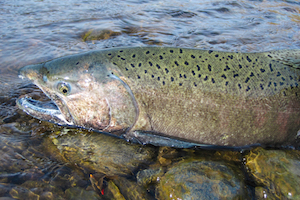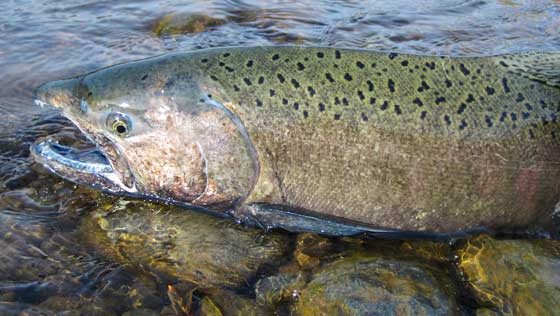Chinook Salmon Spring Fishing

 In most rivers in the southern part of their distribution Chinook Salmon can start showing up en masse in late March and continue well into June. In northern parts of their distribution, the migration will start later and may not last as long.
In most rivers in the southern part of their distribution Chinook Salmon can start showing up en masse in late March and continue well into June. In northern parts of their distribution, the migration will start later and may not last as long.
Chinook Salmon are found in Oregon, Washington and British Columbia’s coastal streams and rivers 12 months of the year.
Spring and fall are the most popular times for fishing due to the number of salmon in these rivers. However each month provides plenty of opportunities to catch Chinook Salmon.
Salmon Fishing in Oregon
Spring Chinook Salmon range, on average, between 10 to 40 lbs/4.5 to 18 kgs. (Summer they’ll grow to 16 to 22 lbs/7 to 10kgs with fish above 30 pounds/13 kgs not uncommon.) And after a long damp cold winter anglers are itching to get out and catch the Chinook brought on by spring. It’s also a time for BBQs to start up. Grilling Chinook Salmon is very popular on the west coast.
Be sure to check the local municipality or guide on the catch limits and fishing season restrictions.
Nutritional Information
Wild Chinook Salmon are high in many minerals and vitamins including selenium, phosphorous, niacin, vitamin B6, B12, protein and also a good source of omega 3 fatty acids.
Note: It’s advisable to check with your doctor or nutritionist on the the appropriate portions and frequency of fish meals. This is because of the pollution levels which are found in every fish with chemicals like PCB’s and elements like mercury. Checking is especially critical for pregnant women.
Dangerous Chemicals in Farmed Salmon
We don’t want to scare you off farmed fish but hope that awareness will bring caution and perhaps change. Pregnant woman need to be especially careful as the following chemicals are used on farmed salmon: Ivermectin, emamectin benzoate, oxytetracycline, florfenicol, Romet 30, sulfadimethoxine and ormetoprim, sulfadiazine and trimethoprim, tricaine methanesulfonate, formaldehyde, florfenicol and hydrogen peroxide.
Furthermore, in 2003 a study showed that farmed salmon show very high levels of PCB, *’farmed salmon are likely the most PCB-contaminated protein source in the United States food supply. On average farmed salmon have 16 times the dioxin-like PCBs found in wild salmon.’
It’s important to understand that all fish everywhere contain these chemicals, which is why it’s important to moderate your consumption. We still eat farmed fish, but only in moderation.
*Source: http://www.health-report.co.uk/pcb-toxic-chemical-farmed-salmon.html


